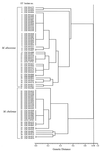Comparison of methods for Identification of Mycobacterium abscessus and M. chelonae isolates
- PMID: 11682537
- PMCID: PMC88494
- DOI: 10.1128/JCM.39.11.4103-4110.2001
Comparison of methods for Identification of Mycobacterium abscessus and M. chelonae isolates
Abstract
Mycobacterium abscessus and Mycobacterium chelonae are two closely related species that are often not distinguished by clinical laboratories despite the fact they cause diseases requiring different treatment regimens. Multilocus enzyme electrophoresis, PCR-restriction fragment length polymorphism analysis of the 65-kDa heat shock protein gene, biochemical tests, and high-performance liquid chromatography of mycolic acids were used to identify 75 isolates as either M. abscessus or M. chelonae that were originally submitted for drug susceptibility testing. Only 36 of these isolates were submitted with an identification at the species level. Using the above methods, 46 of the isolates were found to be M. abscessus and 29 were identified as M. chelonae. Eight isolates originally submitted as M. chelonae were identified as M. abscessus, and one isolate submitted as M. abscessus was found to be M. chelonae. The four identification methods were in agreement in identifying 74 of the 75 isolates. In drug susceptibility testing, all isolates of M. abscessus exhibited resistance to tobramycin (MIC of 8 to > or =16 microg/ml), while all isolates of M. chelonae were susceptible to this drug (MIC of < or = 4 microg/ml). The results suggest that once an identification method is selected, clinical laboratories should be able to easily identify isolates of M. abscessus and M. chelonae.
Figures



References
Publication types
MeSH terms
Substances
LinkOut - more resources
Full Text Sources
Other Literature Sources
Medical
Molecular Biology Databases

